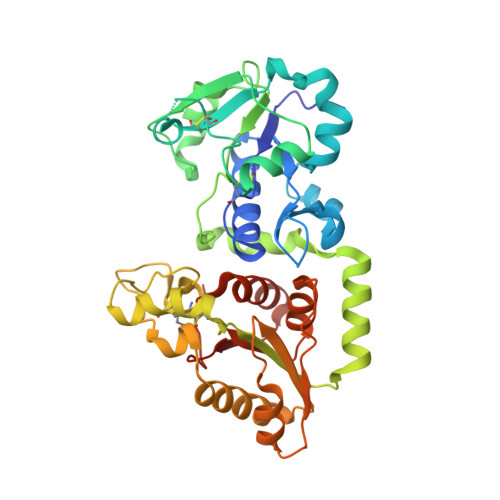Structure of human POFUT1, its requirement in ligand-independent oncogenic Notch signaling, and functional effects of Dowling-Degos mutations.
McMillan, B.J., Zimmerman, B., Egan, E.D., Lofgren, M., Xu, X., Hesser, A., Blacklow, S.C.(2017) Glycobiology 27: 777-786
- PubMed: 28334865
- DOI: https://doi.org/10.1093/glycob/cwx020
- Primary Citation of Related Structures:
5UX6, 5UXH - PubMed Abstract:
Protein O-fucosyltransferase-1 (POFUT1), which transfers fucose residues to acceptor sites on serine and threonine residues of epidermal growth factor-like repeats of recipient proteins, is essential for Notch signal transduction in mammals. Here, we examine the consequences of POFUT1 loss on the oncogenic signaling associated with certain leukemia-associated mutations of human Notch1, report the structures of human POFUT1 in free and GDP-fucose bound states, and assess the effects of Dowling-Degos mutations on human POFUT1 function. CRISPR-mediated knockout of POFUT1 in U2OS cells suppresses both normal Notch1 signaling, and the ligand-independent signaling associated with leukemogenic mutations of Notch1. Normal and oncogenic signaling are rescued by wild-type POFUT1 but rescue is impaired by an active-site R240A mutation. The overall structure of the human enzyme closely resembles that of the Caenorhabditis elegans protein, with an overall backbone RMSD of 0.93 Å, despite primary sequence identity of only 39% in the mature protein. GDP-fucose binding to the human enzyme induces limited backbone conformational movement, though the side chains of R43 and D244 reorient to make direct contact with the fucose moiety in the complex. The reported Dowling-Degos mutations of POFUT1, except for M262T, fail to rescue Notch1 signaling efficiently in the CRISPR-engineered POFUT1-/- background. Together, these studies identify POFUT1 as a potential target for cancers driven by Notch1 mutations and provide a structural roadmap for its inhibition.
Organizational Affiliation:
Department of Biological Chemistry and Molecular Pharmacology, Harvard Medical School, Boston, MA 02115, USA.
















